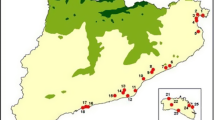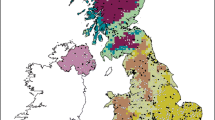Abstract
Butterfly Conservation, in partnership with the Centre for Ecology and Hydrology and Dublin Naturalists’ Field Club, has been coordinating the collation of detailed geographical records of butterfly sightings across Britain and Ireland, mainly made by volunteers, for a continuous period of 15 years since 1995. This has generated a dataset of over 7.5 million records, supplemented by collated historical records. Results at the end of the first five-year period (1995–9) and at the end of the second five-year period (2000–4) indicated significant range declines in many species over a 30-year period (since baseline distributions recorded in the 1970s); for other species, there has been a significant extension of range, principally towards more northerly latitudes. This paper shows the results of a preliminary analysis for the end of the third five-year period (2005–9), to assess progress towards the EU target of halting biodiversity loss by 2010. The findings indicate that populations are continuing to be lost at a similar rate to previous periods, contrary to the 2010 target. In contrast, major northward extensions of range are reported for some mobile generalist species. Conservation successes are also reported for a few species whose declines have been halted and in some cases, reversed. Changes in range and species diversity remain consistent with the primary hypotheses for the causes of change: decreases caused by destruction, deterioration and fragmentation of biotopes and range increases in response to climate warming.






Similar content being viewed by others
References
Asher J, Warren MS, Fox R, Harding PT, Jeffcoate G, Jeffcoate S (2001) The millennium atlas of butterflies of Britain and Ireland. Oxford University Press, Oxford
Botham MS, Brereton TM, Middlebrook I, Cruickshanks KL, Harrower C, Beckmann B, Roy DB (2008) United Kingdom butterfly monitoring scheme report for 2008. CEH Wallingford
Brook S, McCracken M, Bulman CR, Camp P, Bourn NAD (2007) Post-burn bracken Pteridium aquilinum control to manage habitat for the heath fritillary butterfly Mellicta athalia on Exmoor, Somerset, England. Conserv Evid 4:81–87
Cowley MJR, Thomas CD, Thomas JA, Warren MS (1999) Flight areas of British butterflies: assessing species status and decline. Proc R Soc 266:1587–1592
Davies ZG, Wilson RJ, Brereton TM, Thomas CD (2005) The re-expansion and improving status of the silver-spotted skipper butterfly (Hesperia comma) in Britain: a metapopulation success story. Biol Conserv 124:189–198
Davies ZG, Wilson RJ, Coles S, Thomas CD (2006) Changing habitat associations of a thermally constrained species, the silver-spotted skipper butterfly, in response to climate warming. J Animal Ecol 75:247–256
Dennis RLH, Sparks TH, Donato B, Pollard E (2000) Ecological correlates of island incidence and geographical range among British butterflies. Biodivers Conserv 9:343–359
Dennis RLH, Hodgson JG, Grenyer R, Shreeve TG, Roy DB (2004) Host plants and butterfly biology. Do host-plant strategies drive butterfly status? Ecol Ent 29:12–26
Dennis RLH, Shreeve TG, Arnold HR, Roy DB (2005) Does diet breadth control herbivorous insect distribution size? Life history and resource outlets for specialist butterflies. J Insect Conserv 9:187–200
Fox R, Asher J, Brereton T, Roy D, Warren MS (2006) The state of butterflies in Britain and Ireland. Pisces, Newbury
Franco AMA, Hill JK, Kitschke C, Collingham YC, Roy DB, Fox R, Huntley B, Thomas CD (2006) Impacts of climate warming and habitat loss on extinctions at species’ low-altitude range boundaries. Glob Change Biol 12:1545–1553
Heath J, Pollard E, Thomas JA (1984) Atlas of butterflies in Britain and Ireland. Viking, Harmondsworth
Hickling R, Roy DB, Hill JK, Fox R, Thomas CD (2006) The distributions of a wide range of taxonomic groups are expanding polewards. Glob Change Biol 12:450–455
Hill JK, Thomas CD, Huntley B (1999) Climate and habitat availability determine 20th century changes in a butterfly’s range margins. Proc R Soc B 266:1197–1206
Hill JK, Thomas CD, Fox R, Telfer MG, Willis SG, Asher J, Huntley B (2002) Responses of butterflies to 20th century climate warming: implications for future ranges. Proc R Soc B 269:2163–2171
Hodgson JA, Moilanen A, Bourn NAD, Bulman CR, Thomas CD (2009) Managing successional species: modelling the dependence of heath fritillary populations on the spatial distribution of woodland management. Biol Conserv 142:2743–2751
Huntley B, Collingham YC, Willis SG, Green RE (2008) Potential impacts of climatic change on European breeding birds. PLoS One. doi:10.1371/journal.pone.0001439
Mattila N, Kotiaho JS, Kaitala V, Komonen A (2008) The use of ecological traits in extinction risk assessments: a case study on geometrid moths. Biol Conserv 141:2322–2328
Menéndez R, González-Megías A, Hill JK, Braschler B, Willis SG, Collingham Y, Fox R, Roy DB, Thomas CD (2006) Species richness changes lag behind climate change. Proc R Soc B 273:1465–1470
Menéndez R, González-Megías A, Collingham Y, Fox R, Roy DB, Ohlemüller R, Thomas CD (2007) Direct and indirect effects of climate and habitat factors on specialist and generalist butterfly diversity. Ecology 88:605–611
Parmesan C, Ryrholm N, Stefanescu C, Hill JK, Thomas CD, Descimon H, Huntley B, Kaila L, Kullberg J, Tammaru T, Tennant J, Thomas JA, Warren M (1999) Polewards shifts in geographical ranges of butterfly species associated with regional warming. Nature 399:579–583
Pöyry J, Luoto M, Heikkinen RK, Kuussaari M, Saarinen K (2009) Species traits explain recent range shifts of Finnish butterflies. Glob Change Biol 15:732–743
Thomas JA, Telfer MG, Roy DB, Preston CD, Greenwood JJD, Asher J, Fox R, Clarke RT, Lawton JH (2004) Comparative losses of British butterflies, birds, and plants and the global extinction crisis. Science 303:1879–1881
Van Dyck H, van Strien AJ, Maes D, van Swaay CAM (2009) Declines in common, widespread butterflies in a landscape under intense human use. Conserv Biol 23:957–965
Warren MS, Hill JK, Thomas JA, Asher J, Fox R, Huntley B, Roy DB, Telfer MG, Jeffcoate S, Harding P, Jeffcoate G, Willis SG, Greatorex-Davies JN, Moss D, Thomas CD (2001) Rapid responses of British butterflies to opposing forces of climate and habitat change. Nature 414:65–69
Acknowledgments
The authors are grateful to their project partners, the Centre for Hydrology and Ecology and the Dublin Naturalists Field Club; and to The John Ellerman Foundation, the Countryside Council for Wales, Natural England, Northern Ireland Environment Agency and Scottish Natural Heritage for grant contributions to the project. Most vitally of all, the authors are grateful to the many thousands of volunteers who have contributed records to the project over the years, and to the local and regional coordinators for collating and validating the records.
Author information
Authors and Affiliations
Corresponding author
Rights and permissions
About this article
Cite this article
Asher, J., Fox, R. & Warren, M.S. British butterfly distributions and the 2010 target. J Insect Conserv 15, 291–299 (2011). https://doi.org/10.1007/s10841-010-9346-7
Received:
Accepted:
Published:
Issue Date:
DOI: https://doi.org/10.1007/s10841-010-9346-7




